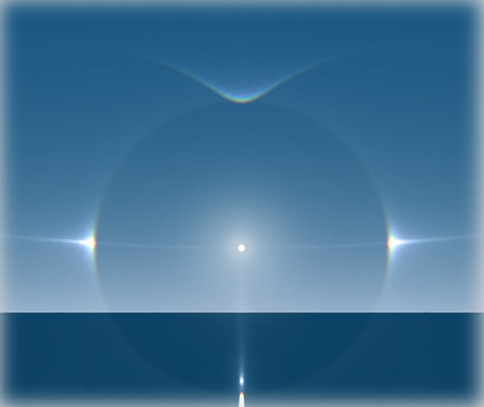Atmospehric Halos
Atmospheric Halos: A Mesmerizing Display of Nature's Beauty
When we gaze up at the sky, we often witness breathtaking displays that captivate our senses. One such phenomenon is atmospheric halos, which range from the familiar circular halo encircling the sun or moon to rare and awe-inspiring events where the entire sky is adorned with intricate arcs. These halos, created by the refraction and reflection of light by tiny ice crystals in the atmosphere, bestow a delicate beauty upon the heavens and provide us with insights into the crystals residing in the clouds.
How are Halos Formed?
Halos are formed when light interacts with ice crystals suspended in the atmosphere. As light passes through these microscopic crystals, it refracts and reflects, resulting in the formation of various optical phenomena. The precise shape and appearance of halos depend on the orientation and characteristics of the ice crystals. Different types of halos can be observed based on the shape, size, and arrangement of these crystals.
Types of Atmospheric Halos
-
22° Circular Halo: The most common type of halo, this circular ring surrounds the sun or moon. It appears at an angle of approximately 22 degrees from the light source and is often accompanied by sundogs, which are bright spots on either side of the halo.
-
Upper Tangent Arc: Positioned above the circular halo, this arc appears as a gentle curve that intersects the halo at its highest point. It adds an ethereal touch to the overall display.
-
Sun Pillar: Sometimes observed beneath the circular halo, a sun pillar is a vertical column of light that extends below the sun. It creates a mesmerizing effect as if a beam of light is shooting upward from the horizon.
-
Circumzenithal Arc: This vibrant arc forms at a higher angle above the sun or moon, creating a smile-like shape. Its vivid colors and distinct curvature make it a striking addition to any halo display.
-
Supralateral Arc: Appearing as a horizontal band extending from the sundogs, this arc adds a unique element to the overall halo spectacle. Its position and orientation give the impression of a celestial rainbow.
When and Where to Witness Atmospheric Halos
To experience the enchanting beauty of atmospheric halos, it is essential to know when and where to look. While halos can occur at any time of the year, they are most commonly observed in colder regions during winter or in high-altitude locations. Additionally, the presence of cirrus clouds, which consist of ice crystals, enhances the likelihood of halo formation.
To increase your chances of witnessing atmospheric halos, try the following:
- Look for halos when the sun or moon is relatively low in the sky, such as during sunrise or sunset.
- Seek out areas with clear skies and minimal light pollution for optimal visibility.
- Be patient and observant, as halos may appear and disappear quickly.
HaloSim: Creating Your Own Halo Displays
For those fascinated by atmospheric optics and eager to explore the intricate patterns of halos, HaloSim offers an immersive experience. This full-color simulator program allows you to recreate various halo displays and delve into their mesmerizing details. By manipulating different parameters, such as crystal shape and orientation, you can gain a deeper understanding of how these captivating phenomena come to life in the sky.
In conclusion, atmospheric halos serve as a reminder of nature's artistic prowess and its ability to create breathtaking displays in the heavens above. Understanding the formation and characteristics of these halos adds a sense of wonder to our observations. So, next time you find yourself gazing at the sky, keep an eye out for these ethereal rings and arcs that transform the ordinary into the extraordinary.
Ice halo displays range from the familiar circle around the sun or moon to rare and prized events when the whole sky is webbed by intricate arcs.
Tiny ice crystals in the atmosphere create halos by refracting and reflecting light.
Halos bestow a delicate beauty to the skies and tell us about the crystals inhabiting the clouds.
Find out how halos are formed, when and where to see them in the skies.
Create your own halo displays by downloading the full colour simulator program, HaloSim.

A circular 22° halo surrounds a low sun. To the left and right are sundogs. Above shines an upper tangent arc and beneath is a sun pillar. HaloSim simulation of halos frequently visible in the sky.
Note: this article has been automatically converted from the old site and may not appear as intended. You can find the original article here.
Reference Atmospheric Optics
If you use any of the definitions, information, or data presented on Atmospheric Optics, please copy the link or reference below to properly credit us as the reference source. Thank you!
-
<a href="https://atoptics.co.uk/blog/atmospehric-halos-2/">Atmospehric Halos</a>
-
"Atmospehric Halos". Atmospheric Optics. Accessed on April 26, 2024. https://atoptics.co.uk/blog/atmospehric-halos-2/.
-
"Atmospehric Halos". Atmospheric Optics, https://atoptics.co.uk/blog/atmospehric-halos-2/. Accessed 26 April, 2024
-
Atmospehric Halos. Atmospheric Optics. Retrieved from https://atoptics.co.uk/blog/atmospehric-halos-2/.